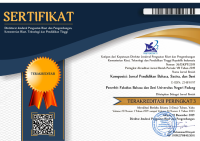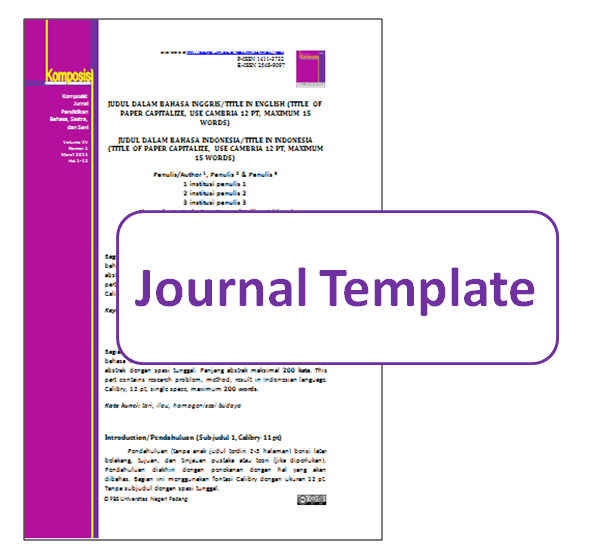STUDENTS’ RESPONSES TO ENGLISH LEARNING AT SMP MAITREYAWIRA BATAM
 ),
), (1) Universal University
 Corresponding Author
Corresponding Author
Copyright (c) 2018 Komposisi: Jurnal Pendidikan Bahasa, Sastra, dan Seni
DOI : https://doi.org/10.24036/komposisi.v19i1.7974
Full Text:
 Language : en
Language : en
Abstract
Keyword: student response, English learning, substantive theory
RESPONS SISWA DALAM PEMBELAJARAN BAHASA INGGRIS DI SMP MAITREYAWIRA BATAM
Abstrak
Tujuan penelitian ini adalah untuk mengeksplorasi dan mendeskripsikan respon siswa terhadap pembelajaran bahasa Inggris di SMP Maitreyawira Batam, dan untuk membuat hubungan antara respon teori berbasis teori substantif. Pendekatan penelitian ini bersifat naturalistik dengan menggunakan kuesioner terbuka. Hasilnya menunjukkan beberapa siswa merasa senang, gembira, menikmati, lebih mudah, dan memiliki dorongan diri dalam belajar bahasa Inggris. Beberapa siswa merasa tidak antusias, bosan, tidak sadar, dan memiliki kompleksitas dalam belajar bahasa Inggris. Peneliti juga menemukan sembilan teori substantif dari empat kategorisasi utama yang menunjukkan tanggapan positif siswa; yaitu (1) Memahami pembelajaran bahasa Inggris menyebabkan siswa merasa senang dan gembira, (2) Terlalu banyak tugas bahasa Inggris yang diberikan pada hambatan siswa, (3) Mampu berkomunikasi dengan orang asing adalah kebutuhan siswa, (4) Kurang berlatih membuat kompleksitas dalam pembelajaran bahasa Inggris untuk siswa, (5) Penyajian materi (kurikulum 2013) membuat beberapa siswa merasa lebih mudah, (6) Materi yang berulang-ulang mengakibatkan siswa merasa bosan, (7) Lebih banyak praktik membuat siswa dapat menikmati bahasa Inggris, (8) Tanpa mengetahui tujuan dari pembelajaran bahasa Inggris menyebabkan siswa merasa tidak antusias dan bosan, dan (9) Kelas yang bising memberi siswa lebih banyak kesulitan dalam belajar bahasa Inggris.
Kata kunci: respon siswa, pembelajaran Bahasa Inggris, teori substantif
References
Applebee, A. N. (1989). The child’s concept of story: Ages two to seventeen. University Of Chicago Press.
B. Kumaradavadivelu. (2003). Understanding language teaching. Brain and Language (Vol. 86). https://doi.org/10.1016/S0093-934X(02)00591-6
Blumenfeld, P. C., Marx, R. W. M., Patrick, H. P., Krajik, J., & Soloway, E. (1997). Teaching for understanding. International handbook of teachers and teaching, (January), 819–878.
Caine, R. N., & Caine, G. (1994). Making connections: Teaching and the human brain. Addison-Wesley.
Cash, C. S. (1993). Building condition and student achievement and behavior. ProQuest Dissertations and Theses, 158-158 . https://doi.org/10.16953/deusbed.74839
Cherubini, L., & Hodson, J. (2008). Ontario Ministry of Education Policy and Aboriginal Learners’ Epistemologies: A Fundamental Disconnect. Canadian Journal of Educational Administration and Policy, (79), 1–33.
Chubb, J. E., & Moe, T. M. (1991). Politics, markets and America’s Schools. British Journal of Sociology of Education. https://doi.org/10.1080/0142569910120306
Clay, T., & Breslow, L. (2007). Why students don’t attend class. MIT Faculty Newsletter, 22(4), 6–7. Retrieved from http://web.mit.edu/fnl
Cole, R. W. (2008). Educating everybody’s children: We know what works—and what doesn’t. in educating everybody’s children: Diverse teaching strategies for diverse learners, 2nd Edition (pp. 1–40).
Dainton, S. (2004). Personalised learning. Forum, 46(2), 56–58. https://doi.org/10.2304/forum.2004.46.2.4
Derewianka, B. (2009). Using appraisal theory to track interpersonal development in adolesent academic writing. In Advances in Language and Education (pp. 142–165).
Entwistle, N., & Tait, H. (1990). Approaches to learning, evaluations of teaching, and preferences for contrasting academic environments. Higher Education, 19(2), 169–194. https://doi.org/10.1007/BF00137106
Felicia, P. (2009). Digital games in schools: A handbook for teachers. European Schoolnet’s Games in Schools, 44.
Flower, L. (1996). Negotiating the meaning of difference. Written Communication, 13(1), 44–92. https://doi.org/10.1177/0741088396013001004
Guthrie, J. T., & Wigfield, A. (2000). Engagement and motivation in reading. In Handbook of reading research, Vol. III (Vol. III, pp. 403–422). https://doi.org/10.1023/A:1016627907001
Hart, J. (2012). Academic language for English language learners and struggling readers: How to help students across content areas. TESOL Quarterly, 46(2), 420–422. https://doi.org/10.1002/tesq.28
House, J. (2006). Text and context in translation. Journal of Pragmatics. https://doi.org/10.1016/j.pragma.2005.06.021
Jordan, A., Glenn, C., & McGhie-Richmond, D. (2010). The Supporting Effective Teaching (SET) project: The relationship of inclusive teaching practices to teachers’ beliefs about disability and ability, and about their roles as teachers. Teaching and Teacher Education, 26(2), 259–266. https://doi.org/10.1016/j.tate.2009.03.005
Lorenzo Galés, M. N., & Piquer Vives, I. (2013). Report and evaluation of the development of CLIL Programmes in Catalonia Introduction: from Catalan immersion to foreign language CLIL. Temps d’Educació, 45, 143–180.
Mahardhani, A. J. (2015). Kepemimpinan ideal kepala sekolah. Jurnal Dimensi Pendidikan Dan Pembelajaran, 3(2), 1–4.
Newmark, P. (1988). A textbook of translation. Text. https://doi.org/10.1017/CBO9781107415324.004
Rendón, L. I. (1994). Validating culturally diverse students: Toward a new model of learning and student development. Innovative Higher Education, 19(1), 33–51. https://doi.org/10.1007/BF01191156
Said, K., Kurniawan, A., & Anton, O. (2018). Development of media-based learning using android mobile learning. Journal of Theoretical and Applied Information Technology, 96(3).
Shernoff, D. J., & Csikszentmihalyi, M. (2009). Flow in schools: Cultivating engaged learners and optimal learning environments. Handbook of Positive Psychology in Schools, (November 2015), 131–145. https://doi.org/10.2307/1423345
Struyven, K., Dochy, F., & Janssens, S. (2010). “Teach as you preach”: The effects of student-centred versus lecture-based teaching on student teachers’ approaches to teaching. European Journal of Teacher Education, 33(1), 43–64. https://doi.org/10.1080/02619760903457818
Unesco. (2014). Practical tips for teaching large classes embracing diversity: Toolkit for creating inclusive, learning-friendly environments specialized booklet 2 A Teacher‛s Guide.
Willis, J. (2007). The neuroscience of joyful education supporting good teaching practices with neuroscience. Educational Leadership, 64, 1–4.
 Article Metrics
Article Metrics
 Abstract Views : 2446 times
Abstract Views : 2446 times
 PDF Downloaded : 263 times
PDF Downloaded : 263 times
Refbacks
- There are currently no refbacks.
Copyright (c) 2018 Komposisi: Jurnal Pendidikan Bahasa, Sastra, dan Seni

This work is licensed under a Creative Commons Attribution-NonCommercial 4.0 International License.











